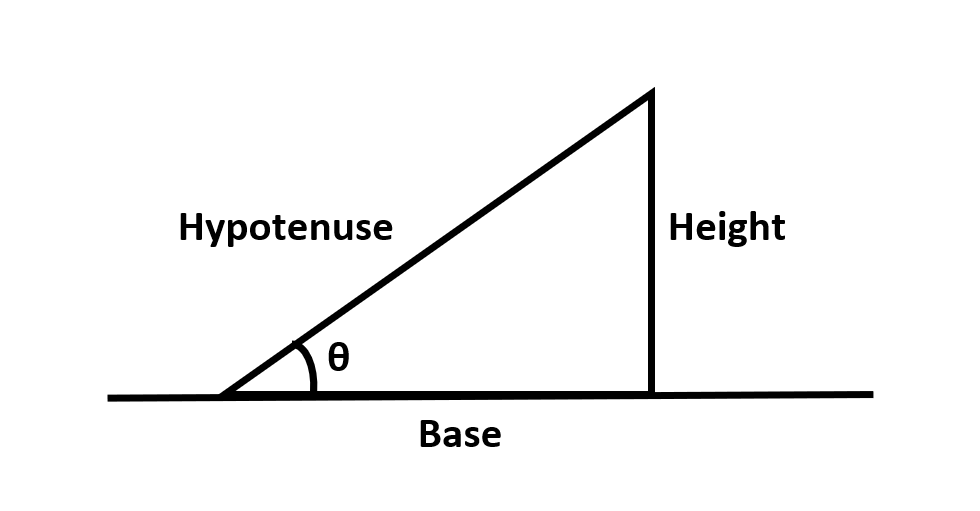
The mechanical advantage of an inclined plane is:
(A) always greater than unity
(B) always less than unity
(C) equal to unity
(D) none of the above
Answer
522.3k+ views
Hint: To understand what is the mechanical advantage of an inclined plane, we first need to define an inclined plane. As the name suggests, it is a plane (made up of any material like wood, iron, etc.) which rests at a certain angle with the surface on which it has been placed, that is, this inclined plane makes a certain angle with the horizontal known as the angle of inclination.
Complete answer:
An inclined plane can be shown with the diagram drawn below:

It has a right triangular shape in nature which has some defined parameters. Here, we can see the parameters of the inclined plane. These parameters are:
The height of the incline.
The base of the incline.
The hypotenuse or the slant height of the incline. And lastly,
The angle of inclination of the inclined plane, denoted by $\theta $ .
Now, we will see what does it mean by the term mechanical advantage of an inclined plane.
The mechanical advantage of an inclined plane is defined as the ratio of its slant height to the height of the inclined plane. Or, this could be said, the ratio of hypotenuse and height of the inclined plane. Mathematically, we can write this as:
$ \text{Mechanical Advantage = }\dfrac{\text{Hypotenuse}}{\text{Height of incline}}$
Since, an incline is always a right-angled triangle, therefore its hypotenuse is always greater than its height (that could be any of the two sides). Therefore, we can say that:
$ \Rightarrow \dfrac{\text{Hypotenuse}}{\text{Height of incline}}$ > $1$
$ \therefore \text{Mechanical Advantage }$ > $1$
Hence, the Mechanical advantage of an inclined is always greater than unity. So, option (A) is the correct option.
Note:
Mechanical advantage is basically the secant and cosecant of the angle of inclination. These are some very useful and common terms and one should know the proper definition of these terms. These terms could be given as a data-set in a question, like the mechanical advantage of an incline is X, so find the angle of inclination.
Complete answer:
An inclined plane can be shown with the diagram drawn below:

It has a right triangular shape in nature which has some defined parameters. Here, we can see the parameters of the inclined plane. These parameters are:
The height of the incline.
The base of the incline.
The hypotenuse or the slant height of the incline. And lastly,
The angle of inclination of the inclined plane, denoted by $\theta $ .
Now, we will see what does it mean by the term mechanical advantage of an inclined plane.
The mechanical advantage of an inclined plane is defined as the ratio of its slant height to the height of the inclined plane. Or, this could be said, the ratio of hypotenuse and height of the inclined plane. Mathematically, we can write this as:
$ \text{Mechanical Advantage = }\dfrac{\text{Hypotenuse}}{\text{Height of incline}}$
Since, an incline is always a right-angled triangle, therefore its hypotenuse is always greater than its height (that could be any of the two sides). Therefore, we can say that:
$ \Rightarrow \dfrac{\text{Hypotenuse}}{\text{Height of incline}}$ > $1$
$ \therefore \text{Mechanical Advantage }$ > $1$
Hence, the Mechanical advantage of an inclined is always greater than unity. So, option (A) is the correct option.
Note:
Mechanical advantage is basically the secant and cosecant of the angle of inclination. These are some very useful and common terms and one should know the proper definition of these terms. These terms could be given as a data-set in a question, like the mechanical advantage of an incline is X, so find the angle of inclination.
Recently Updated Pages
Master Class 11 Economics: Engaging Questions & Answers for Success

Master Class 11 English: Engaging Questions & Answers for Success

Master Class 11 Social Science: Engaging Questions & Answers for Success

Master Class 11 Biology: Engaging Questions & Answers for Success

Class 11 Question and Answer - Your Ultimate Solutions Guide

Master Class 11 Business Studies: Engaging Questions & Answers for Success

Trending doubts
1 Quintal is equal to a 110 kg b 10 kg c 100kg d 1000 class 11 physics CBSE

What is a periderm How does periderm formation take class 11 biology CBSE

What are porins class 11 biology CBSE

Why is steel more elastic than rubber class 11 physics CBSE

Differentiate between red algae and brown algae class 11 biology CBSE

What is boron A Nonmetal B Metal C Metalloid D All class 11 chemistry CBSE




